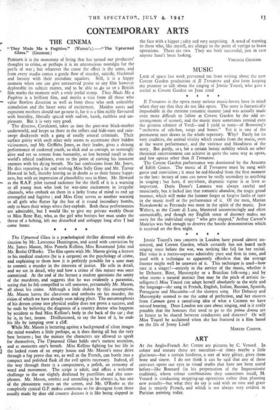ART
AT the Anglo-French Art Centre are pictures by C. Venard. In colour and texture these are succulent—at times maybe a little
glutinous—but a certain hardness, a sort of wiry glitter, gives them bone and sinew. I do not think it can be said that any of these canvases opens our eyes to visual truths that have not been stated before—like Bonnard (in his perpetuation of the Impressionist tradition), whose colour combinations they sometimes recall, M. Venard is conducting mopping-up operations rather than planning new assaults—but what they do say is said with an ease and grace that is entirely French, and which is not always very evident in Parisian painting today.
Elsewhere it is largely theatre week. Gimpel Fils are showing a selection of decor and costume designs from English ballets produced since 1939 ; Leslie Hurry's designs for the recent Covent Garden production of Turandot are to be seen at Roland, Browse and Delbanco's. Our achievements in ballet in the middle of war-time difficulties were impressive, but it must be admitted that some of our decor has been of a rather routine order. The limitations of space at the former gallery tend to exaggerate this businesslike but not always imaginative approach on the part of the designers. Some of the better-known and more eminent painters are omitted, while designs completely conceived in terms of theatre do not usually make good exhibition pictures. (Sophie Fedorovitch, for example, whose backcloth to Symphonic Variations is one of the outstanding efforts of the last few years, goes for nothing here.) Nevertheless, in the costume designs particularly, there are some pretty talents to be studied. By comparison with this light sparring, Mr. Hurry lands a wallop in the midriff and follows it up with a half-nelson. This is the real thing, in the great tradition. His tortuous, Oriental baroque may recall the exotic splendours of Bakst and Benois. What is more to the point is that these designs do not merely decorate the production, but lift it on to another level.
Also at Roland, Browse and Delbanco's are some fine examples of work by Walter Greaves. Greaves was an uneven painter, but whenever he broke the shackles of bondage to Whistler, he showed that he knew a thing or two himself. Half a dozen of the pictures here show more genuine, honest feeling than Whistler ever achieved, and it is one of the tragedies of the century that their author's life should have ended as it did. It is, in fact, a hundred years since Greaves was born, and it is fitting and welcome that the centenary should be honoured with this exhibition.
M. H. MIDDLETON.







































 Previous page
Previous page